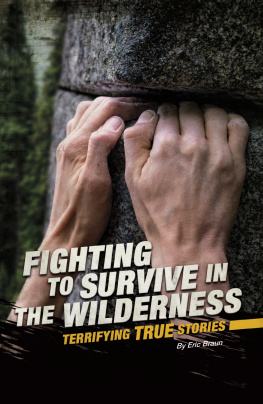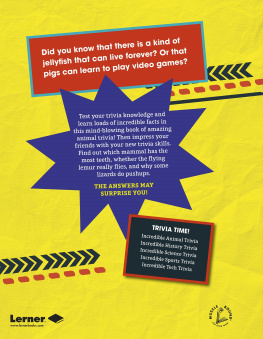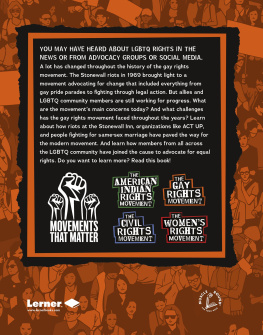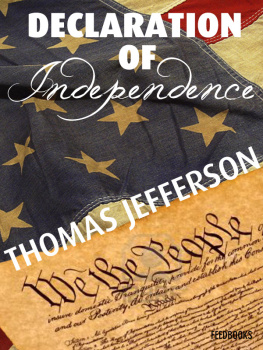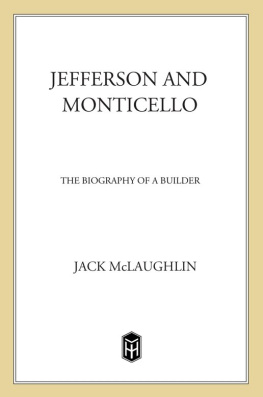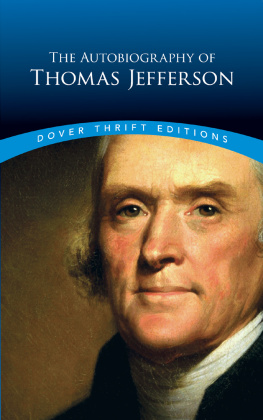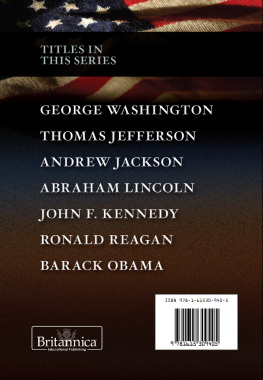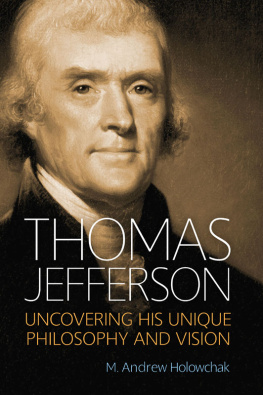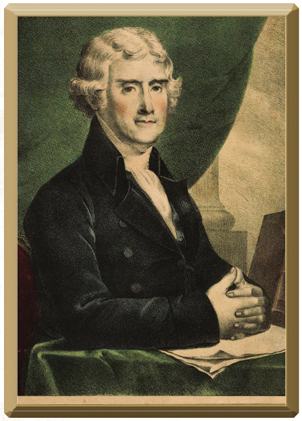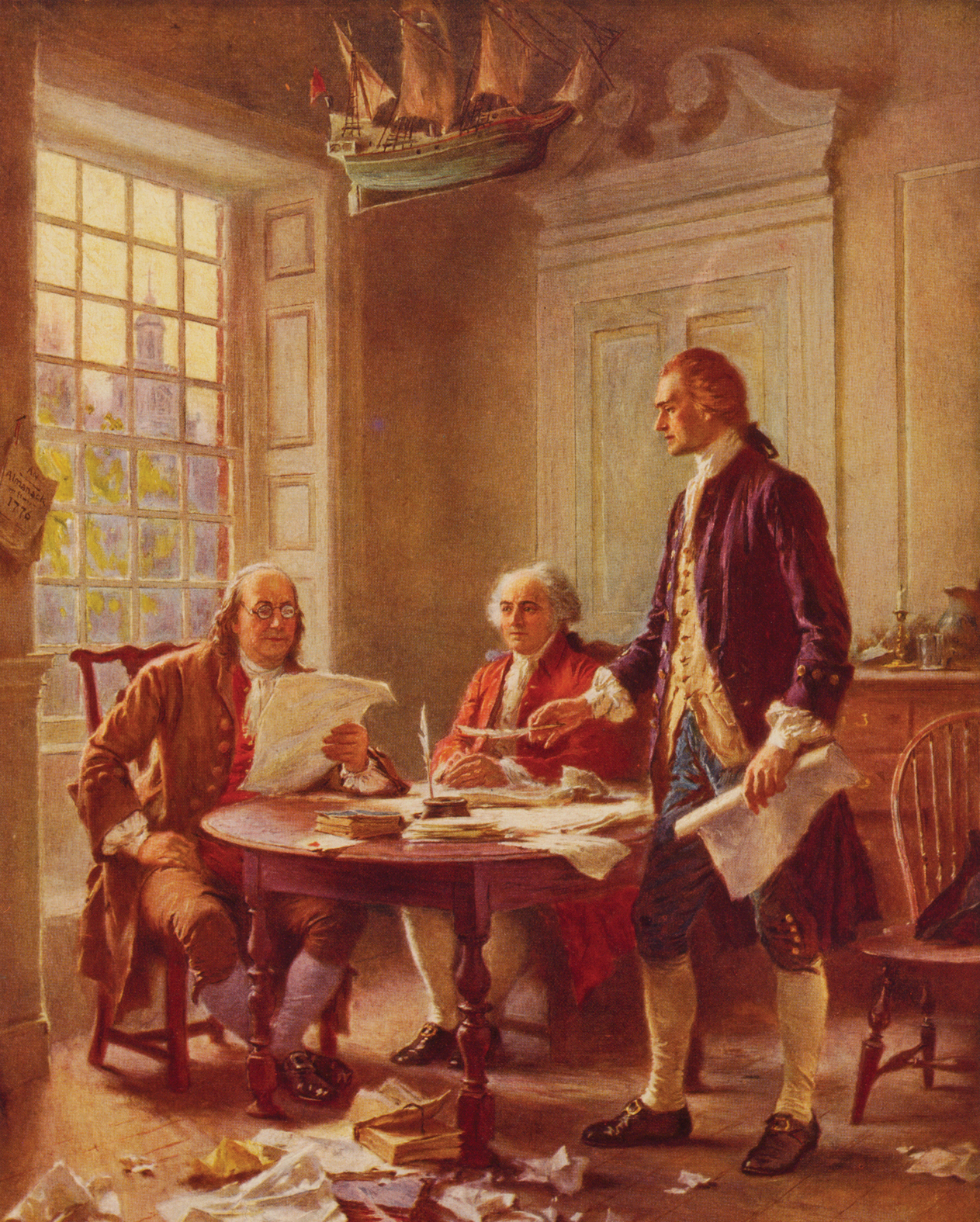CHAPTER ONE
AN ACCOMPLISHED LIFE
In the Declaration of , Thomas Jefferson wrote that all men are createdequal, an idea that has come to symbolize the very core of the United States ofAmerica. He not only wrote the Declaration, he served his country in many ways inits early years, from secretary of state to president. He is one of the most belovedof the American founding fathers. His most important achievements continue to shapethe lives of Americans today.
AUTHOR OF THE DECLARATION OF INDEPENDENCE
It was late spring in 1776, and American colonists were getting fed up. For yearsthey had enjoyed a good relationship with their mother country, Great Britain. GreatBritain bought tobacco, cotton, wheat, and other crops from the colonies. And Britainhelped protect the colonies from attack by other Europeans or American Indians. Inreturn, the colonists bought nearly all their goods from Great Britain. They obeyedBritish laws and paid taxes to the British government.
Everything worked well for many years after the colonies were established, beginningwith the first colony of Virginia in 1607. But by 1776, Great Britain was in trouble.The country was spending too much money on a long war with France. The British governmentincreased taxes on the colonies to raise money. When some colonists complained, GreatBritain cracked down. Britains leaders refused to lower the taxes. They also sentmore troops to the colonies to prevent rebellion. This, of course, made many colonistsangry. More and more people started talking about independence.
By May 1776, eight of the 13 colonies supported independence from Great Britain.In June, leaders from all 13 colonies discussed the issue at the Second ContinentalCongress in Philadelphia. On June 7, Richard Henry Lee from Virginia made the firstcall for independence. Not everyone supported the idea. But the Congress selecteda Committee of Five to write a document stating their reasons for demanding independence.The committee included John Adams of Massachusetts, Roger Sherman of Connecticut,Benjamin Franklin of Pennsylvania, and Robert R. Livingston of New York. It alsoincluded Thomas Jefferson of Virginia.
Jefferson was the only southerner on the Committee of Five. He was also younger thanmost of the others, but he was known as a talented writer. The committee selectedhim to write the first draft of the Declaration of Independence. Jefferson didntwant to write it. He asked John Adams to do it. In a letter to a friend, Adams laterdescribed how he convinced Jefferson to undertake the task. When Jefferson suggestedAdams write it, Adams replied that this would not go over well with the people.
Benjamin Franklin (left) and John Adams (center) reviewed Jeffersons (right) draftand helped him shape the Declaration of Independence.
I am obnoxious, suspected, and unpopular, Adams told his friend. But people likedJefferson. Adamss final reason that Jefferson should write the document was simple.As he said, You can write ten times better than I can.
Jefferson replied, I will do as well as I can.
And so he sat at his desk in his rented rooms in Philadelphia and wrote the firstdraft of the Declaration of Independence. He included the reasons why the 13 colonieswere declaring themselves independent. He also defined the legal and natural rightsof people. These, he wrote, include Life, Liberty and the pursuit of Happiness.
Once he had a first draft, Jefferson asked Adams and Franklin for feedback. He madesome changes, and just 17 days later, on July 4th, the Congress approved the Declarationof Independence. They had already voted in favor of independence from Great Britaintwo days previously. The president of the Continental Congress, John Hancock, wasthe first to sign it. By August 2nd, all 56 colonial had signed the document.
Over the next several weeks, copies of the Declaration were delivered throughoutthe colonies. It was printed in newspapers, and it was read aloud to soldiers inthe Continental Army. The effect was that more people began to support the idea ofindependenceand revolution.
A CHAMPION FOR RELIGIOUS FREEDOM
Before Thomas Jefferson died, he wrote his own epitaph. In the words he wanted onhis gravestone, he included the three things he was most proud of. Although he hadbeen a lawyer and a legislator, a governor and a U.S. president, he didnt mentionthose things.
His list included two of his other well-known accomplishments: He had written theDeclaration of Independence, one of the most important documents in world history.And he had founded the University of Virginia, which became one of the most admiredcolleges in the world. Those were indeed two important milestones in his life.
What was the third item he named? Jefferson included the fact that he had writtenthe Virginia Statute for Religious Freedom. Today, few people have heard of this1785 law. But there was a reason Jefferson was so proud of it. It was one of thefirst attempts in world history to grant people the freedom of religion.
Until then, nearly every country had a major religion. People who practiced thatreligion had more power and more rights than those who didnt. For instance, in manyEuropean countries, the Catholic Church was the major religion. People who were notCatholic were discriminated against. They often could not hold positions of poweror own property. They enjoyed fewer rights.
In Great Britain in the 1700s, the state religion was the Anglican Church. Britishcitizens had to obey its laws. They had to pay taxes to the church. So did peoplewho lived in Britains North American colonies. That included the Commonwealth ofVirginia, where Jefferson was a legislator.
Jefferson strongly believed that Virginia had to change. He felt that citizens couldnot be truly free if they could not practice their religion of choice. He wrote,It does me no injury for my neighbor to say that there are twenty gods or no god.It neither picks my pocket nor breaks my leg. And he felt that the government shouldnot be connected to any church.
Jefferson got his chance to make this change in October 1776. The Virginia GeneralAssembly asked him and four other men to review Virginia laws. Their job was to updatethe laws to reflect the values of the colony of Virginia. The goal was to alter thelaws so they would reflect Virginias independence from Britain. In all, Jeffersonand the others rewrote 126 laws into new bills.
Virginias General Assembly would have to vote on the bills before they could belaw. The Assembly never passed most of them. But in 1786, it passed Bill No. 82.This became the Virginia Statute for Religious Freedom. The new law said that governmenthad to be separated from church activities. And it made it illegal to discriminateagainst anyone based on their religion.
When his bill became law in Virginia, Jefferson was in France. By then, he was servingas U.S. minister to that country. He was so excited about the new law that he hadit translated into French. That way those around him could learn of it.
The idea of separating church and state was shocking to most Europeans. But Jeffersonslaw laid the groundwork for the American culture of religious . And it waslater included in the first amendment to the U.S. Constitution. It begins, Congressshall make no law respecting an establishment of religion, or prohibiting the freeexercise thereof...



